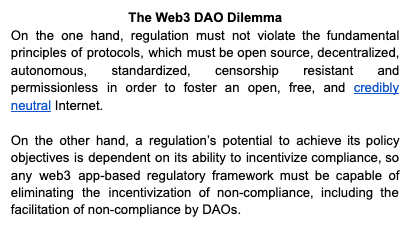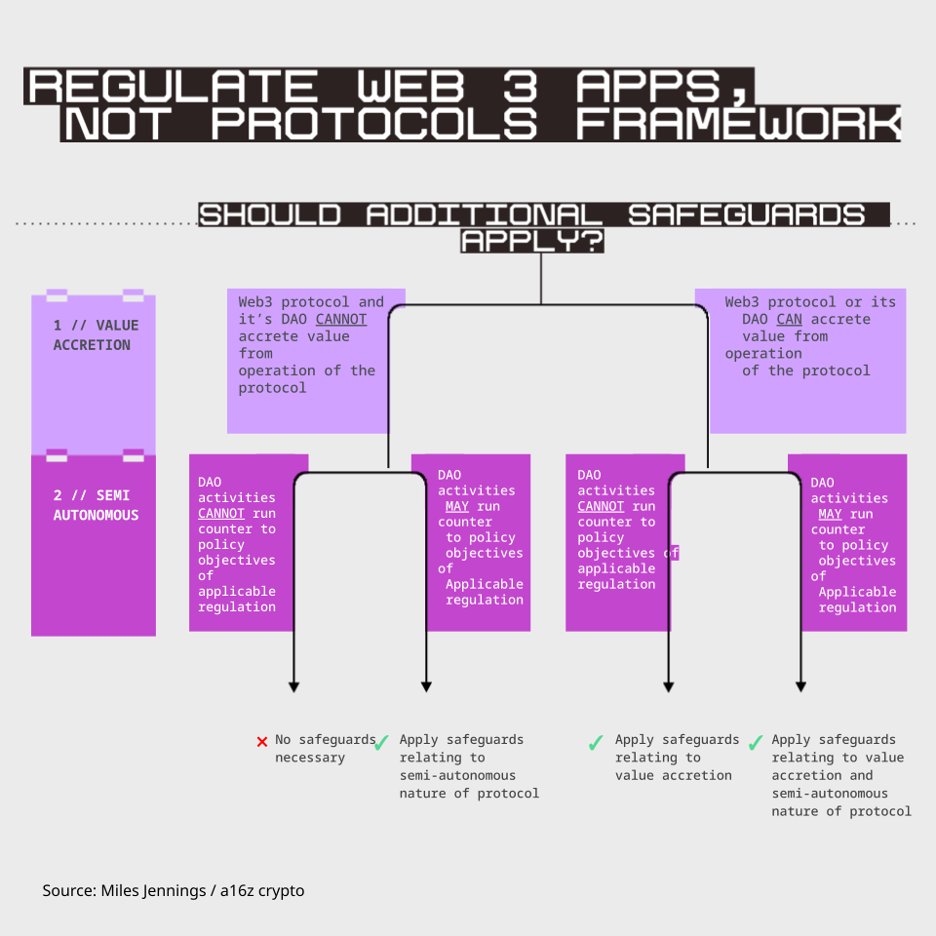Thread
(1/11) Today, we published Part 3 of the @a16zcrypto “Regulate Web3 Apps, Not Protocols” series to complete the foundation of our framework and to address a significant loophole: DAOs 🧵
a16zcrypto.com/regulate-web3-apps-not-protocols-part-iii-the-web3-dao-dilemma/
a16zcrypto.com/regulate-web3-apps-not-protocols-part-iii-the-web3-dao-dilemma/
2/ Part 3 covers:
1⃣ the Web3 DAO Dilemma
2⃣ the importance of DAOs
3⃣ how to solve the Web3 DAO Dilemma with regulatory safeguards
4⃣ how to design compliant protocol and decentralized governance while preserving the fundamental principles of protocols.
1⃣ the Web3 DAO Dilemma
2⃣ the importance of DAOs
3⃣ how to solve the Web3 DAO Dilemma with regulatory safeguards
4⃣ how to design compliant protocol and decentralized governance while preserving the fundamental principles of protocols.
3/ The RANP framework relies heavily on using web1 as an analogy for web3 — but this analogy can only go so far because the unique characteristics of web3 protocols make them more susceptible to misuse by bad actors circumventing app-based regulation.
4/ Web1 protocols do not accrue value and are fully autonomous.
So, no one profits from the general use of the email protocol (SMTP) and no one is empowered to act on SMTP’s behalf, meaning SMTP’s functioning does not incentivize anyone to facilitate illicit uses of SMTP.
So, no one profits from the general use of the email protocol (SMTP) and no one is empowered to act on SMTP’s behalf, meaning SMTP’s functioning does not incentivize anyone to facilitate illicit uses of SMTP.
5/ But, web3 protocols can be designed to accrue value (fees, commissions, etc.) and be semi-autonomous.
So, the opposite is true. The DAO of a web3 protocol could be set up to profit from illicit uses of the protocol, and be incentivized to facilitate such illicit use.
So, the opposite is true. The DAO of a web3 protocol could be set up to profit from illicit uses of the protocol, and be incentivized to facilitate such illicit use.
6/ Ultimately, these characteristics enable bad actors to operate DAOs like businesses to circumvent app-based regulatory schemes (the exact issue in CFTC v. Ooki). But, applying app regulations to DAOs would destroy the utility of protocols.
This is the Web3 DAO Dilemma:
This is the Web3 DAO Dilemma:
7/ The most obvious solution to the dilemma is to make web3 protocols DAO-less. But, that would be a grave mistake — DAOs provide several critical benefits that underpin web3’s core value proposition.
Such a drastic step is also unnecessary.
Such a drastic step is also unnecessary.
8/ Instead, we propose a novel approach — pairing app-based regulations with additional narrowly-tailored safeguards that limit incentive structures and restrict DAO activities that would otherwise undermine the policy objectives of app-based regulations.
9/ For example, a hypothetical app-based regulation that prohibits trading of tokenized derivatives using web3 apps could be paired with safeguards that prohibit a DAO from profiting from such trading and from engaging in activities designed to increase such trading.
10/ Safeguards like these could eliminate incentives to circumvent regulation and create incentives to encourage use of regulated apps, all while preserving the fundamental principles of protocols.
That means app-based regulation can succeed without sacrificing web3 freedoms!
That means app-based regulation can succeed without sacrificing web3 freedoms!
11/ With this 3rd installment of RANP, we have a complete foundation for a regulation-agnostic web3 framework.
We'll now seek to use the framework as the basis for protecting web3 protocols from the coming wave of rules and regulation.
We'll now seek to use the framework as the basis for protecting web3 protocols from the coming wave of rules and regulation.
+/ Thanks for reading. The full text of Part 3 can be found here: a16zcrypto.com/regulate-web3-apps-not-protocols-part-iii-the-web3-dao-dilemma/
Feedback is welcomed/appreciated — the feedback we received from the community on Parts 1 and 2 has been enormously helpful.
Feedback is welcomed/appreciated — the feedback we received from the community on Parts 1 and 2 has been enormously helpful.
++/ Finally, if you’re looking for Parts 1 and 2:
Part 1: a16zcrypto.com/web3-regulation-apps-not-protocols/
Part 2: a16zcrypto.com/regulate-web3-apps-not-protocols-part-ii-framework-for-regulating-web3-apps/
Part 1: a16zcrypto.com/web3-regulation-apps-not-protocols/
Part 2: a16zcrypto.com/regulate-web3-apps-not-protocols-part-ii-framework-for-regulating-web3-apps/

